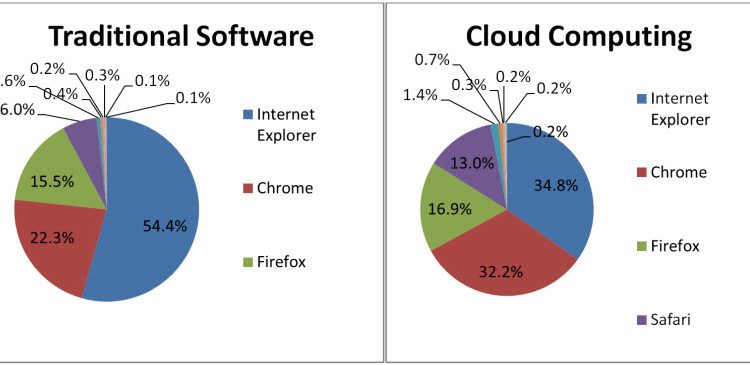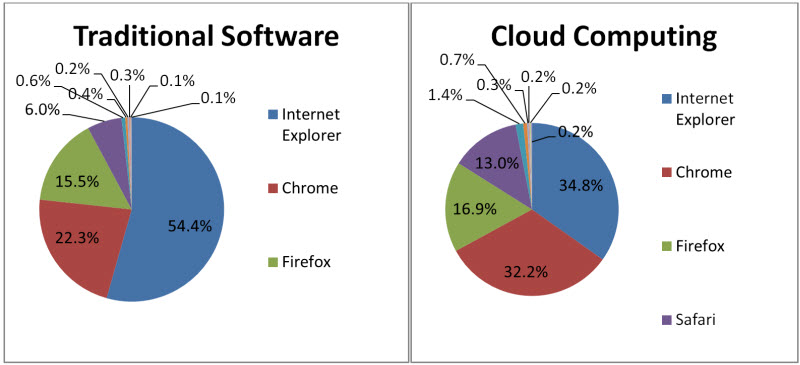It’s late.
You’re sitting behind the dull glow of a computer screen. You’ve worked countless hours trying to squeeze every last drop of insight out of your company’s big data.
Overall, you think you’ve done a great job …
Except for a lone report on browser data that keeps you thinking for hours.
It has to be telling you something about customer behavior – your intuition says the numbers are screaming something, but what?
The browser report can be a tough nut to crack, but once opened, it can provide a unique insight into your customer profile.
Knowing is only half the battle
Recently, I was running analytics for a company that had two types of products. One product was a traditional software package that could be downloaded onto the customer’s computer. The other product centered on cloud-based computing.
The browser reports between these two products was vastly different and provided some insights not previously discovered in the data.
While both reports had the same ranking of the browsers (IE, Chrome, Firefox, Safari, etc.), the interesting findings came when looking at the individual breakdowns of each graph.
Internet Explorer (IE) has a significantly smaller slice of the cloud-based computing pie. IE lost this mainly to Chrome, Firefox and Safari.
This led to an age old question:
“What does this tell me?”
In order to answer that, we must delve more deeply into the ongoing browser wars.
The decline of Internet Explorer
There is some argument over which browser currently has the most users worldwide. While there is much debate, most research indicates Chrome is gaining on (if it hasn’t surpassed) IE in usage.
This is partly due to Chrome and Firefox being viewed as the choice browsers of younger, tech-savvy users. The largest portion of traffic using Chrome and Firefox is under the age of 45 while the majority of IE users are 45 and older. This is true even on the mobile platform.
Also, given that IE is the factory browser on most PCs bought, we can assume most Chrome and Firefox users downloaded those browsers.
Unfortunately, this gives us no idea how many users truly prefer IE, as some users may put no thought into which browser they use.
In fact, my mom uses IE because in her view, “That’s what was on it when we pulled it out of the box and that’s good enough for me.”
Consequently, it’s almost impossible to determine what percentages of users prefer IE and what percentage is due to the “good enough for me” mentality.
Chrome and Firefox users are less likely to display a “good enough” mentality because they must go out of their way to download and install the browser on their computer.
Since browser selection is more important to this group, they fit into a younger, more tech-savvy demographic than the average user.
Insights into demographics
While none of this can be applied to any specific user, it can be used to see a somewhat clearer big picture view of what typical browser users look like (sounds like big data in general, huh?).
Customers that are less technologically proficient may prefer to have the software on their computer. They may feel safer having all of the calculations done locally “in case something happens” to the data.
However, customers that are younger and more comfortable with technology may not have the same anxiety using a cloud computing service.
This is simply one case of trying to draw out useful demographics from the browser report.
With the right mindset, the browser report could become a powerful tool in the constant struggle to better understand your ideal customer.
Related Resources:
Marketing Analytics: 4 tips for productive conversations with your data analyst
A/B testing: How we drilled down to discover the truth behind a 445% lift
Online Testing: Microsite A/B split test increases lead rate 155%





Folks, I would say that installing robust analytics solution should be that first step for every website owner out there!!!
I have strong faith on Mozilla Firefox Browser, it has good strength to prove it firefox is much better than another browser. I never denied that any browser doesn’t have that potential, yes I also accept that Chrome also works very proficiently,
Exactly, Chrome and Firefox is under the age of 45 while the majority of IE users are 45 and older.